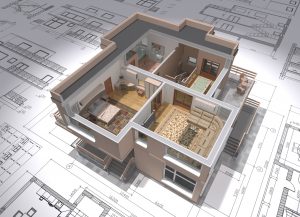 When it comes to home design, many people ask us which is better: a one-story home or a two-story home. The answer, of course, is… it depends.
When it comes to home design, many people ask us which is better: a one-story home or a two-story home. The answer, of course, is… it depends.
Let’s walk through the primary feature differences, as well as the different perspectives on whether that’s an advantage or a disadvantage. This thought process can help you decide which design type is right for you.
Stairs or no stairs
This feature makes a single-story home a great option for people with bad knees or other mobility concerns, or for people who simply don’t like going up and down the stairs every day. If you’re thinking you’ll live in your forever home, well, forever, then you might not want those stairs when you’re older.
On the other hand, some people may consider stairs an advantage in their home due to their individual needs and how they live in their home. For example, many families with children, or families who homeschool, want a space that is secluded from company so any mess is easily hidden. That’s easy to do when the mess is upstairs and company is downstairs.
Heating and cooling efficiency
All things being equal (meaning good design and construction), both types of homes are perfectly manageable when it comes to climate control. However, a single story won’t require separate heating and cooling zones (systems) just because there’s an upstairs. This makes the design, execution, and maintenance of the heat and air system simpler for a one-story home, which is helpful over the long haul.
But think about the summer sun in Oklahoma and how it beats down down on your roof, cooks your attic, and makes your air conditioner work hard. Now think of cutting the amount of roof that’s exposed to the sun in half. The first floor of a two-story is shaded by the upper floor, which means it can be cooled with much less capacity because of the shade. With good heat and air system design, the second floor can be cooled properly using a little over half the capacity needed for the whole house.
Exterior maintenance
One-story homes win here, if exterior maintenance is something you plan to do yourself. With the eaves of the roof closer to the ground, it’s easier to clean the gutters, repaint the outside when needed, and inspect the roof for damage or wear. The long-term maintenance needs are definitely something to consider when building your forever home.
Squeaky floors
There’s never a squeaky floor in a one-story home. If noise (or lack of noise) in your home matters to you, that’s something to consider. In Oklahoma, where we don’t typically build basements (see why here), the floor is probably a concrete slab, which will never squeak.
Cost per square foot
Comparing the same square footage between a one-story and a two-story home, the cost per square foot of the one-story will be higher. Why? Two of the most expensive elements of the home—the foundation or slab and the roof—serve double duty in a two-story. With the two-story home, a single square foot of slab and a single square foot of roof can give you two square feet of living space. In a one-story home, a single square foot of both only gets you a single square foot of living space.
There are many more considerations, of course, but these are certainly some things to think about when considering one-story or two-story designs for your custom home.